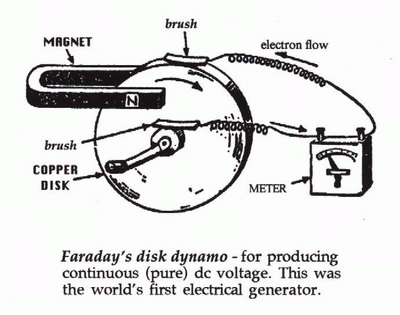
The importance of the Homopolar Generator cannot be emphasized enough. It is a drag free generator that produces electricity by simply rotating a magnet in space!
Common generators will get bogged down when you draw electricity from them – for example if you light up a bunch of bulbs on a gasoline generator set, the engine has to work harder to compensate for that load, thereby burning up more gasoline.
But with a Homopolar Generator, you can draw electricity from it and it does not bog down what is turning the magnet. And this is just one of the many benefits of this kind of generator.
If you literally take a disc magnet and put a shaft through it, you can spin it and you will produce a voltage potential between the circumference of the magnet and the shaft that the magnet is rotating around. Think about it – you’re producing electricity by doing nothing more than rotating a magnet in space. There are no generator coils or anything like what is necessary in a normal generator! Simple, simple, simple!
This is all good, but the downfall is that you wind up with current, but almost no usable voltage and this has been the case since Michael Faraday first invented the Homopolar Generator, which was in fact the very first generator. This has been the case since 1831.
For nearly 200 years, the Homopolar Generator has been more of a novelty to most although a few low voltage high current applications have been powered by large industrial homopolar generators.
At the 2017 Energy Science & Technology Conference, I review the basic history and the most notable names who have been involved with this kind of generator and then I show a working model that I have used to charge some capacitors up to 150-160 volts! If you consider the fact that for the size of magnets I was rotating, I would be lucky to wind up with 0.5 volts! I have a neon bulb connected to the capacitor and the bulb blinks every time the capacitors are up to the trigger voltage of these neons, which is about 95-105 volts.
What this shows is that I’m able to get 200 TIMES THE VOLTAGE than is expected from this kind of generator, which could very well take the entire experimental world of homopolar generators to a whole other level of practicality unlike anything has ever been demonstrated. It appears that at the conference, the small demonstration model achieved a worlds record by showing that I have wound up with more voltage from a Homopolar Generator that anyone has achieved in the last two centuries!
This is VERY SIMPLE and I would encourage you to get a copy of this and experiment with it because even if you have very little technical knowledge, you can build this and make it work!

Get your copy here: https://emediapress.com/shop/high-voltage-n-machine-advancing-homopolar-generator/















